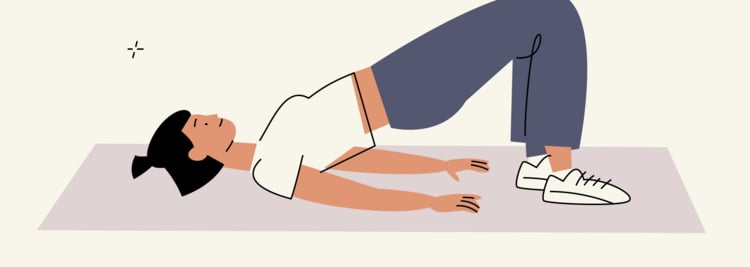Pelvic floor therapy is a specialized type of physical therapy that can help treat or prevent chronic pain and other symptoms of pelvic floor dysfunction. It can also help you during pregnancy and delivery.
-
Tracking cycle
-
Getting pregnant
-
Pregnancy
-
Help Center
-
Flo for Partners
-
Anonymous Mode
-
Flo app reviews
-
Flo Premium New
-
Secret Chats New
-
Symptom Checker New
-
Your cycle
-
Health 360°
-
Getting pregnant
-
Pregnancy
-
Being a mom
-
LGBTQ+
-
Quizzes
-
Ovulation calculator
-
hCG calculator
-
Pregnancy test calculator
-
Menstrual cycle calculator
-
Period calculator
-
Implantation calculator
-
Pregnancy weeks to months calculator
-
Pregnancy due date calculator
-
IVF and FET due date calculator
-
Due date calculator by ultrasound
-
Medical Affairs
-
Science & Research
-
Pass It On Project New
-
Privacy Portal
-
Press Center
-
Flo Accuracy
-
Careers
-
Contact Us
Pelvic Floor Therapy: Pelvic Floor Physical Exercises and Massage Essentials


Every piece of content at Flo Health adheres to the highest editorial standards for language, style, and medical accuracy. To learn what we do to deliver the best health and lifestyle insights to you, check out our content review principles.
What is pelvic floor therapy?
Your pelvic floor is the area inside your pelvis that extends from your pubic bone to your tailbone (coccyx). The pelvic floor is made up of layers of muscles and connective tissue. These structures can stretch and are formed around three different structures: your vagina, urethra, and anus. Some of the most essential functions of the pelvic floor include:
- Providing support for your uterus, bladder, and bowels during pregnancy
- Helping you control your bladder and bowels
- Contributing to the structures that support your spine
- Allowing you to enjoy sex and have more powerful orgasms
- Helping a baby’s head rotate and get into the proper position during childbirth
- Preventing constipation and incontinence
Just like any other muscle in your body, your pelvic floor can be strengthened through exercise. A strong pelvic floor can help prevent pelvic floor dysfunction, which can cause symptoms such as chronic pain and incontinence.
Pelvic floor therapy is a form of physical therapy that can help strengthen the structures of your pelvic floor. There are different strategies that can be used to perform pelvic floor therapy. These range from simple exercises you can do every day to more specialized techniques that need to be performed by a health care professional.
Symptoms of pelvic floor dysfunction
Your pelvic floor can weaken because of aging, trauma, or surgery. It’s common to experience symptoms of pelvic floor dysfunction during menopause or after pregnancy.
However common it might be, it’s important to have pelvic floor dysfunction and its symptoms evaluated by a doctor and treated if necessary.
Some of the most common symptoms of pelvic floor dysfunction include:
- Urinary or fecal incontinence
- Constipation
- Vaginal gas, commonly known as “queefing”
- Chronic lower back pain caused by increased tension in your pelvic floor muscles
- Vaginal pain during sex, gynecological examinations, or tampon insertion
- Pain in your genitals or rectum
- Involuntary pelvic muscle spasms
- Feeling like you need to defecate or urinate often
- Painful urination
How is pelvic floor physical therapy done?
The first thing you should do if you’re experiencing symptoms of pelvic floor dysfunction is to book an appointment with your ob-gyn. They’ll examine you and can determine the cause of your symptoms. If necessary, they may refer you to a pelvic floor specialist.
A certified pelvic floor physical therapist may recommend different techniques to treat your pelvic floor dysfunction. This will largely depend on your individual characteristics and the severity of your symptoms. In some cases, treating pelvic floor dysfunction could require the combined efforts of pelvic floor therapists, gynecologists, and mental health professionals.
Some of the techniques that may contribute to relieving pelvic floor dysfunction include:
- Education — Learning how the pelvic floor functions and how to keep it healthy can help you develop better habits.
- Pelvic floor exercises — Simple exercises can strengthen and stretch your pelvic floor muscles, improving flexibility and muscle strength.
- Pelvic floor manual therapy — Internal massage may be used to promote circulation, posture, and flexibility.
- Vaginal dilators — Using these devices can help you relax your pelvic floor to relieve chronic pain and promote pleasurable sex.
- Biofeedback — During this procedure, a probe is inserted into your vagina to help you see how your pelvic floor muscles work. This can help you gain greater awareness of your pelvic floor muscles.
- Pelvic floor electrical stimulation — Low-voltage electrical currents are sometimes used to help learn how to effectively contract your pelvic floor muscles.
Take a quiz
Find out what you can do with our Health Assistant
Pelvic floor therapy exercises

Several simple exercises can help stimulate your pelvic floor muscles to improve strength, mobility, and flexibility. These exercises include:
Bridge exercise
This exercise can be particularly helpful for strengthening your pelvic floor after a C-section or vaginal delivery. They can also build up your glutes. To perform a bridge exercise, follow these steps:
- Lie down on your back with bent knees, keeping your feet flat on the floor and your arms to your sides.
- Use your glutes and pelvic muscles to lift your butt off the ground.
- Hold this pose for 3 to 8 seconds.
- Perform up to 3 sets of 10 repetitions, according to your endurance.
Squats
Although most people are familiar with squats, not all squats are meant to promote a stronger pelvic floor. Rather than performing wide-legged or deep squats, shallow and narrow repetitions are more beneficial for your pelvic floor muscles.
To perform pelvic-floor-enhancing squats, follow these steps:
- Stand with your feet hip-width apart.
- Bend your knees, keeping your back straight and leaning forward slightly.
- Don’t go lower than what is comfortable for you.
- Focus on contracting your pelvic floor muscles as you stand up slowly.
- Repeat 10 times and rest between additional sets.
Squeeze and release
- Get comfortable sitting on a firm chair or lying down with your knees bent.
- A fast squeeze is performed by contracting your pelvic floor muscles as quickly as possible and then letting them relax quickly as well. These squeezes can protect you against incontinence.
- A slow squeeze is performed by contracting your pelvic floor muscles at about half the speed and power of your fast squeeze, holding it for 10 seconds. These squeezes will increase your muscles’ strength and stamina.
- It’s critical to fully relax between each squeeze.
- Start by performing three sets of three for each of the squeezes.
- As you improve your endurance, try performing three fast squeezes followed by ten slow squeezes.
- Do four sessions of fast and slow squeezes a day.
Pelvic floor massage therapy
Pelvic floor massage may help relieve excessive tension in your pelvic floor. Discuss performing at-home pelvic floor massage with your doctor before attempting to perform this technique. This massage technique can also be useful for preparing your perineum for childbirth to prevent tears.
Vaginal massage can be more comfortable after you’ve had a warm bath or shower. Then, follow these steps:
- Wash your hands.
- Find a comfortable and private position.
- Apply a small amount of massage oil on your perineum and the entrance of your vagina.
- Using your thumb inside your vagina and your index finger outside, gently apply pressure to stretch your skin and massage from side to side.
- Apply this pressure until you feel a soft, tingling sensation.
- Stop massaging if you feel any pain.
- Softly insert your thumb approximately two to three centimeters inside your vagina, and perform a “U” shaped massage, applying pressure toward your anus.
- Massage for approximately 10 minutes each day.
Internal pelvic floor therapy: vaginal dilators
Vaginal dilators can be useful for treating different pelvic floor problems. These small devices can be used to retrain tissues in and around your vagina to relax and contract as desired.
Dilators are sometimes prescribed to prevent or improve scar tissue damage from childbirth, surgery, or radiotherapy. They can also be used to relieve vaginal or vulvar tissues that are hypersensitive to the touch.
If your doctor or pelvic floor therapist prescribes vaginal dilators, they’ll probably instruct you to use them for short amounts of time and build up your endurance. Doctors often recommend using dilators for 1 minute at first and building up to 5–10 minutes over time.
When using vaginal dilators, it’s imperative that you always feel comfortable. Going too fast can cause pain, trigger muscle spasms, and aggravate the initial problem. Slow progress, on the other hand, can help relieve symptoms of pelvic floor dysfunction.
Pelvic floor therapy at home
Yoga practice has a relaxing effect on your muscles, and many yoga poses can strengthen your pelvic muscles.
Other simple at-home techniques to work out your pelvic floor muscles include Kegels and reverse Kegels. You may also want to ask your pelvic floor therapist about using Kegel weights to increase your pelvic floor strength.
What does pelvic floor physical therapy entail?
When it comes to pelvic floor therapy, it’s important to be consistent to achieve good results. Some people need months of physical therapy to find relief for their symptoms, and in some cases, maintenance therapy is needed to prevent issues from coming back.
Pelvic floor physical therapy can reduce a myriad of symptoms caused by pelvic floor dysfunction, ranging from incontinence to chronic pain and sexual dysfunction. If you suspect that you may be experiencing pelvic floor dysfunction, discuss your symptoms with your doctor to determine the best course of action for you.


Hey, I'm Anique
I started using Flo app to track my period and ovulation because we wanted to have a baby.


The Flo app helped me learn about my body and spot ovulation signs during our conception journey.


I vividly
remember the day
that we switched
Flo into
Pregnancy Mode — it was
such a special
moment.
Real stories, real results
Learn how the Flo app became an amazing cheerleader for us on our conception journey.




